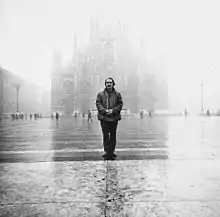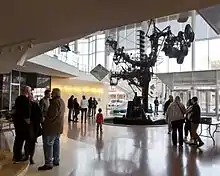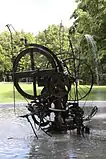Jean Tinguely
Jean Tinguely (22 May 1925 – 30 August 1991) was a Swiss sculptor best known for his kinetic art sculptural machines (known officially as metamechanics) that extended the Dada tradition into the later part of the 20th century.[1] Tinguely's art satirized automation and the technological overproduction of material goods.
Jean Tinguely | |
|---|---|
 Jean Tinguely portrait by Lothar Wolleh | |
| Born | 22 May 1925 |
| Died | 30 August 1991 (aged 66) |
| Nationality | Swiss |
| Spouse(s) |
|
| Partner(s) | Milena Palakarkina (1986–1991) |


Life
Born in Fribourg, Tinguely grew up in Basel, but moved to France in 1952 with his first wife, Swiss artist Eva Aeppli,[2] to pursue a career in art. He belonged to the Parisian avantgarde in the mid-twentieth century and was one of the artists who signed the New Realist's manifesto (Nouveau réalisme) in 1960.[3]
His best-known work, a self-destroying sculpture titled Homage to New York (1960), only partially self-destructed at the Museum of Modern Art, New York City,[4] although his later work, Study for an End of the World No. 2 (1962), detonated successfully in front of an audience gathered in the desert outside Las Vegas.
Tinguely married fellow Swiss artist Eva Aeppli in 1951. In 1971, he married his second wife, Niki de Saint Phalle with whom he collaborated on several artistic projects, such as the Hon – en katedral[5] or Le Cyclop.[6]
Tinguely died in 1991 at the age of 66 years in the Bern Hospital of heart failure.
Public works
- Chaos I (1974), sculpture in The Commons, Columbus, Indiana, USA
- Le Cyclop outside of Milly-la-Forêt.
- The Stravinsky Fountain (fr: La Fontaine Stravinsky) near the Centre Pompidou, Paris (1983), a collaboration with Niki de Saint Phalle.
- Carnival Fountain (Fasnachtsbrunnen) (1977) in Basel.
- Tinguely Fountain (1977) in Basel.
- Lifesaver Fountain on Königstrasse in Duisburg, Germany, a collaboration with Niki de Saint Phalle
- Jo Siffert Fountain (commonly called Tinguely Fountain), Fribourg, Switzerland
- La Cascade, sculpture in the Carillon Building lobby, Charlotte, North Carolina, USA
- Métamatic generative sculptures (1950s)
- Luminator (1991), on loan until 2014 to the EuroAirport Basel-Mulhouse
Hon – en katedral
Hon – en katedral (Swedish: "She, a Cathedral") was an art installation made in collaboration with Niki de Saint-Phalle, that was shown at the Moderna Museet in Stockholm in 1966. The exhibition consisted of a sculpture of a colorful pregnant woman lying on her back with her legs wide apart. The sculpture was 25–26 meters long, about 6 meters high and 11 metres wide. It was built of scaffolding and chicken wire covered with fabric and fiberglass, painted with brightly coloured poster paint. Through a door-sized entry in the location of the woman's vagina, visitors could go into the sculpture. Inside was a screen showing Greta Garbo films, a goldfish pond, and a soft drink vending machine. Johann Sebastian Bach's organ music played through speakers. The exhibition was created by Niki de Saint-Phalle, Tinguely and Per Olov Ultvedt. It had 80,000 visitors during the exhibition period from June 4 to September 9, 1966.
Noise music recordings
- 1963 'Sounds of Sculpture', 7, Minami Gallery, Tokyo, Japan_[Tinguely's sculptures recorded by avant-garde composer Toshi Ichiyanagi during Japanese exhibition]
- 1972 'Méta', book+7_, Propyläen Verlag, Stockholm
- 1983 'Sculptures at The Tate Gallery, 1982'_, Audio Arts cassette
- 1983 'Meta-Harmonie H' incl. in ‘Meridians 2_ compmqenan ate a pie
- 2001 'Relief Meta-Mechanique Sonore I' incl. in 'A Diagnosis' compilation, Revolver-Archiv für Aktuelle Kunst, Frankfurt am Main, Germany
Influence on others
- In Arthur Penn's Mickey One (1965) the mime-like Artist (Kamatari Fujiwara) with his self-destructive machine is an obvious Tinguely tribute.
- Survival Research Laboratories, directed by Mark Pauline (USA)
- D.A. Therrien (USA)
- Prominent kinetic sculptor Arthur Ganson described Tinguely as his "primary spiritual artistic mentor", and paid homage to him in his work "Tinguely in Moscow".[7]
Gallery of Works
 Tinguely, Machines - Le Transport, early 1960s; scrap metal components
Tinguely, Machines - Le Transport, early 1960s; scrap metal components.jpg.webp) Tinguely, Gears, 1967; scrap old metal components (part of Le Paradis Fantastique)
Tinguely, Gears, 1967; scrap old metal components (part of Le Paradis Fantastique) Tinguely, Chaos I, 1971–72; scrap metal components
Tinguely, Chaos I, 1971–72; scrap metal components Tinguely, Large Spiral, 1971–73; steel-plates
Tinguely, Large Spiral, 1971–73; steel-plates_-_Z%C3%BCrichhorn_2013-04-13_16-21-43_(P7700).JPG.webp) Tinguely, Heureka, 1972–73; scrap metal components
Tinguely, Heureka, 1972–73; scrap metal components Tinguely, detail of Heureka, 1972–73; old components
Tinguely, detail of Heureka, 1972–73; old components Tinguely, one piece of Carneval Fountain, 1977; location: in front of Museum Tinguely, Basel
Tinguely, one piece of Carneval Fountain, 1977; location: in front of Museum Tinguely, Basel Tinguely, title unknown, late 1970s; scrap metal components
Tinguely, title unknown, late 1970s; scrap metal components.jpg.webp) Tinguely, Fontaine Stravinski, 1983; co-production with Niki de Saint Phalle, near Saint-Merri, Paris
Tinguely, Fontaine Stravinski, 1983; co-production with Niki de Saint Phalle, near Saint-Merri, Paris 'Tinguely, Jo Siffert Fountain, 1984; scrap metal components
'Tinguely, Jo Siffert Fountain, 1984; scrap metal components
Further reading
- Museum Tinguely in Basel
- Chapter on Tinguely in Calvin Tomkins' The Bride and Her Bachelors.
- K.G. Pontus Hultén: Jean Tinguely 'Méta'. London: Thames & Hudson, 1975 (original German version Frankfurt/M.: Ullstein, 1972)
- G. Bischofsberger: Catalogue raisonné, 3 Vols. Basel, 1982.
- Margit Hahnloser-Ingold: Pandämonium – Jean Tinguely. Bern: Benteli, 1988 (rather hagiographic, but with interesting personal memories and background material)
- Heidi E. Violand: Jean Tinguely's Kinetic Art or A Myth of the Machine Age. Diss, New York University, 1990
- Museum Jean Tinguely (eds.): Die Sammlung. (The collection) Bern: Benteli, 1996 (incl. an interesting biographical report by Margit Hahnloser: "Jean Tinguely und die Schweiz")
- Museum Jean Tinguely (eds.): Jean le Jeune. Basel: Benteli, 2002 (incl. a biographical text by Jocelyn Daignes about Tinguely's early love of materials and machines, his pacifism, and his Catholicism, p. 23-65).
References
- Ian Chilvers and John Glaves-Smith (eds), A Dictionary of Modern and Contemporary Art, Oxford University Press, p.709
- Leu, Aia. The Art of the Leu Family, SeedPress, 2012, ISBN 978-0-9551109-2-4. (p. 13).
- Ian Chilvers and John Glaves-Smith (eds), A Dictionary of Modern and Contemporary Art, Oxford University Press, p.709
- "The Garden Party", report about Homage to New York (1960) by Billy Klüver, reprinted in: Pontus Hilton (ed.): The Machine as seen at the End of the Mechanical Age exhibition catalogue published by the Museum of Modern Art, New York, 1968, p. 168-171.
- http://nikidesaintphalle.org/50-years-since-hon/
- http://www.atlasobscura.com/places/le-cyclop
- "Tinguely in Moscow - Arthur Ganson". Arthur Ganson. Retrieved 2018-02-21.
External links
| Wikimedia Commons has media related to Jean Tinguely. |
| Wikiquote has quotations related to: Jean Tinguely |
- Tinguely-Museum in Basel
- Biography by the Tinguely Museum in Basel
- Art Cyclopaedia: Jean Tinguely
- https://web.archive.org/web/20060210001214/http://www.art-public.com/cyclop/cyclop_g.htm
- videos: Tinguely's kinetic fountains in Basel and Paris
- Métamatic Research Initiative
- Lecture by Kaira Cabañas (PhD, Princeton University) Homage to New York: Jean Tinguely's Destructive Art delivered November 20, 2008 in New York City at Museum of Modern Art
- Jean Tinguely in American public collections, on the French Sculpture Census website
